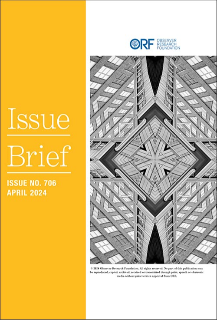
As was expected, Nancy Pelosi’s visit to Taiwan on 2 August 2022 infuriated Beijing, which called it a “betrayal of China”. It retaliated by conducting a series of military drills against Taiwan and halted cooperation with the United States (US) over military and climate change issues. However, the deterioration of the US-China relations over Taiwan is nothing new; rather this is the fourth such crisis since the post-War era. Taiwan has been a primary irritant between the US and China since the Cold War and remains so despite the three communiques—1972, 1979, and 1982—and the ‘Six Assurances’ that guide the US-China relations. However, the present crisis has escalated the cross-strait tensions to a possible US-China military clash over Taiwan. There were already serious apprehensions about the impending Chinese attack on the island nation in the context of the Russia-Ukraine war. Pelosi’s visit thus gave China the pretext to settle the issue of ‘lost territory’ and fulfil the goal of Chinese rejuvenation. However, the deterioration in US-China relations is not merely a result of power rivalry but is symptomatic of a clash of frontiers between the two countries.
Expansionist ambitions
It is intriguing to note that both the US and China are a product of their frontier experiences. If the idea of the US has taken shape owing to its westward expansion that resulted in the annihilation of the Red Indians and conquest of the wilderness, the idea of China was shaped by its incremental expansion from its Central Plains that resulted in pacifying the nomadic tribes at its northwestern periphery. The expansion of the frontier in both countries meant the expansion of civilisational values. Embedded in their frontier experience is the idea of otherness that essentially promoted the ‘us’ versus ‘them’ mentality, validating the self by perpetuating the other as the enemy. Arguably, this common goal of expanding and subduing the frontier have shaped the territorial idea, and particularly, the national psyche and identity of both countries.
Taiwan has been a primary irritant between the US and China since the Cold War and remains so despite the three communiques—1972, 1979, and 1982—and the ‘Six Assurances’ that guide the US-China relations.
Broadly seen, American expansion began with European colonial settlement on the Eastern Atlantic coast in the decades of the 1600s and ended with the admission of the last few territories on the Western Pacific coast in the 1900s. Notably, this era of massive migration and settlement of the West that was precipitated by President Thomas Jefferson’s Louisiana purchase was not a peaceful one but entailed more than two centuries of American perpetration of war and violence, giving rise to the expansionist attitude known as ‘Manifest Destiny’. Along with it, came the famous frontier thesis in 1893, put forward by Frederick J. Turner, who theorised that the “frontier promoted the formation of a composite nationality for the American people”. By the 1890s, when the opportunities for internal territorial expansion were exhausted, the US turned towards colonial acquisitions overseas, thus ushering in a period of US imperialism that led not to the closing of the frontier but the opening of new frontiers overseas, including Guam, Hawaii, and the Philippines. In this trail, came the US announcement of the Open-Door policy in 1899 that called for equal opportunities for commercial exploitation of China, for all countries trading with the Chinese. With the rise of Japanese imperialism in the 19th century, a struggle for supremacy ensued between Japan and the US that culminated with the defeat of Japan in World War II. However, the Japanese defeat did not cause the end of US frontier expansion in the post-War era. Rather the 1950-53 Korean War ushered the US back into the East Asian theatre with its sprawling structure of Cold War alliance relationships. Integral to this US alliance system was the US-Taiwan Mutual Defence Treaty of 1955. Following the defeat of the Kuomintang (KMT) regime in the civil war, China had hoped to regain its erstwhile centrality in East Asia. But far from regaining its centrality, China confronted a far more precarious situation with the US recognising Taiwan as the only legitimate legal entity in the United Nations, thus, igniting a severe legitimacy crisis for the People’s Republic of China.
Fear of the ‘other’
Turning to the Chinese frontier experience, since the 3rd century BCE, the powerful Xiongnu tribes whom the Chinese called ‘barbarians’, threatened China’s northern frontier. It was in the process of exploration and conquest of the northern frontier that the imperial notion of China forming the core Central Kingdom emerged. Notably, these non-Chinese alien groups were also the rulers of China for almost half of the period of Chinese history. This domination of the barbarians not only generated a kind of fear for all non-Chinese but also brought to the fore the challenge of competing identities in the imperial past. This fear of the ‘other’ was only exacerbated further in the 19th century with the advent of Western and Japanese imperialism that not only tore apart China into several colonial enclaves but also de-centred the Chinese power from the East Asian order. More specifically, China lost out to Japan which it looked down upon as a peripheral and subordinate power in its neighbourhood. Arguably, this vulnerability associated with the memory of a loss of centrality injected a sense of siege mentality amongst the Chinese.
This domination of the barbarians not only generated a kind of fear for all non-Chinese but also brought to the fore the challenge of competing identities in the imperial past.
It is beside the point that while for the US, the frontier experience was a saga of optimism and triumphalism, and a victory of democracy and liberty, for China, it was more of vulnerability and insecurity. Nonetheless, the moot point is that both are a product of their frontier experiences. And this frontier which embodied war and violence essentially fostered a spirit of expansionism and power competition.
The current reality
Fast forward to the current geopolitics, the frontier continues to impact both China and the US. The post-2008 Global Financial Crisis saw a rise of a proactive China, hell-bent on ousting the US from dominating its periphery. Beijing, therefore, crafted the ‘March West’ policy that became the basis for Xi Jinping’s Belt and Road Initiative (BRI). To confront the US’ ‘Rebalance to Asia’ strategy crafted in 2011 under Obama’s presidency, China created a pivot of its own that shifted its geopolitical priority westward to Eurasia, South and West Asia, and Africa-Latin America, and thereby, reconfigured the notion of the frontier which not only included the neighbouring regions but the US as well. Under Xi Jinping, the periphery strategy got a further fillip by moving away from the western lenses that segregated the world into regions—East Asia, South Asia, Central Asia, or Asia-Pacific, and viewing it instead in the Chinese framework of Tianxia (All under Heaven) where the periphery is regarded as forming one organic whole to the Chinese Central Kingdom (Zhong Guo). In this reconfigured notion of the frontier, the BRI is not only a tactical tool to implement the periphery policy, but more significantly, it encompassed areas well-beyond China’s territorial limits. This expansive Chinese definition of periphery naturally pits against the US idea of frontier underscored in the Indo-Pacific strategy.
Under Xi Jinping, the periphery strategy got a further fillip by moving away from the western lenses that segregated the world into regions—East Asia, South Asia, Central Asia, or Asia-Pacific, and viewing it instead in the Chinese framework of Tianxia (All under Heaven) where the periphery is regarded as forming one organic whole to the Chinese Central Kingdom (Zhong Guo).
The 2017 US Free and Open Indo-Pacific strategy is, on one level, an American response to Chinese BRI through the creation of a network of like-minded states to limit Chinese belligerence. On another level, it is emblematic of American frontier strategy perpetuated through the propagation of American ideals and value systems underscored in the principles of democracy, human rights, rule of law, and freedom of the seas. The aim of the frontier strategy is thus, to perpetuate the greatness of American norms and values and present it as a superior vision to that of Xi Jinping’s world view typified by socialist values and collective spirit.
The current US-China rivalry is, thus, not simply a power competition to dominate the globalised world order, but it is more about a clash of frontiers between the two, each motivated to universalise its core values while marginalising the other. And in the process, the goal of the clash is to establish the frontier as the new core. As Frederick Turner aptly said, “moving westward, the frontier became more and more American.”
Indeed then, the clash of the frontier between the US and China is inevitable. And Nancy Pelosi’s Taiwan visit has simply brought this truth nearer.
The views expressed above belong to the author(s). ORF research and analyses now available on Telegram! Click here to access our curated content — blogs, longforms and interviews.




 PREV
PREV


